An Analysis of Social Memory, Collective Action, and Social Change
VerifiedAdded on 2023/01/09
|11
|3024
|61
Essay
AI Summary
This essay delves into the multifaceted relationship between social memory, collective action, and social change. It begins by establishing the importance of social memory in shaping group identities and understanding the past, contrasting it with the cognitive psychology perspective. The paper then explores how social memory influences collective action by reinforcing group solidarity and providing historically nuanced information. Drawing on examples from historical and contemporary events, the essay examines how political elites and social groups use memory to construct identities and justify actions. It differentiates between social and collective memory, highlighting the dynamic interplay between history, culture, and individual experience. The essay further analyzes how social memory reconstructs recollections to align with modern ideas, emphasizing the role of communication and cultural narratives in shaping individual and collective understanding of the past. Finally, the essay concludes by emphasizing the adaptability of social memory and its role in addressing current challenges through a reinterpretation of the past.
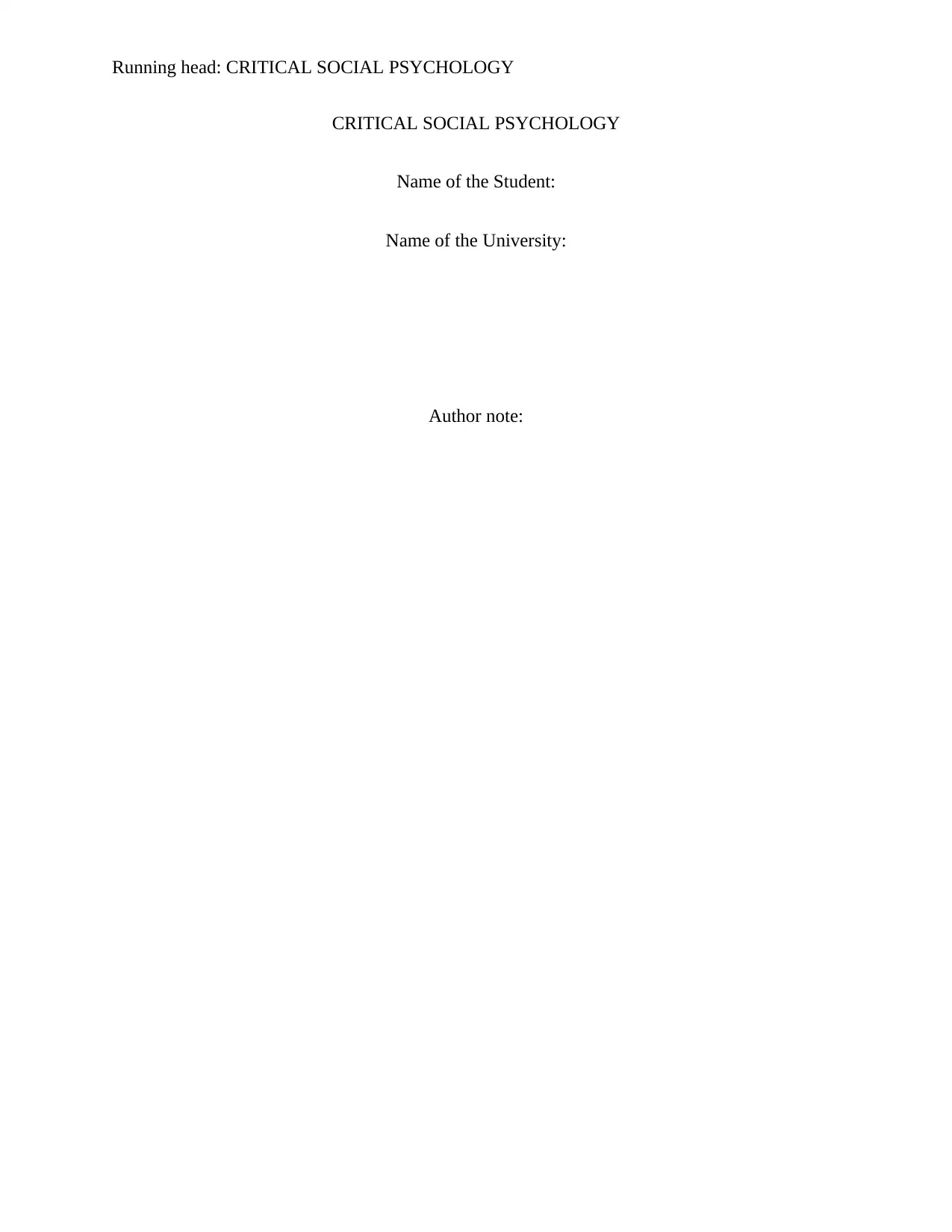
Running head: CRITICAL SOCIAL PSYCHOLOGY
CRITICAL SOCIAL PSYCHOLOGY
Name of the Student:
Name of the University:
Author note:
CRITICAL SOCIAL PSYCHOLOGY
Name of the Student:
Name of the University:
Author note:
Paraphrase This Document
Need a fresh take? Get an instant paraphrase of this document with our AI Paraphraser
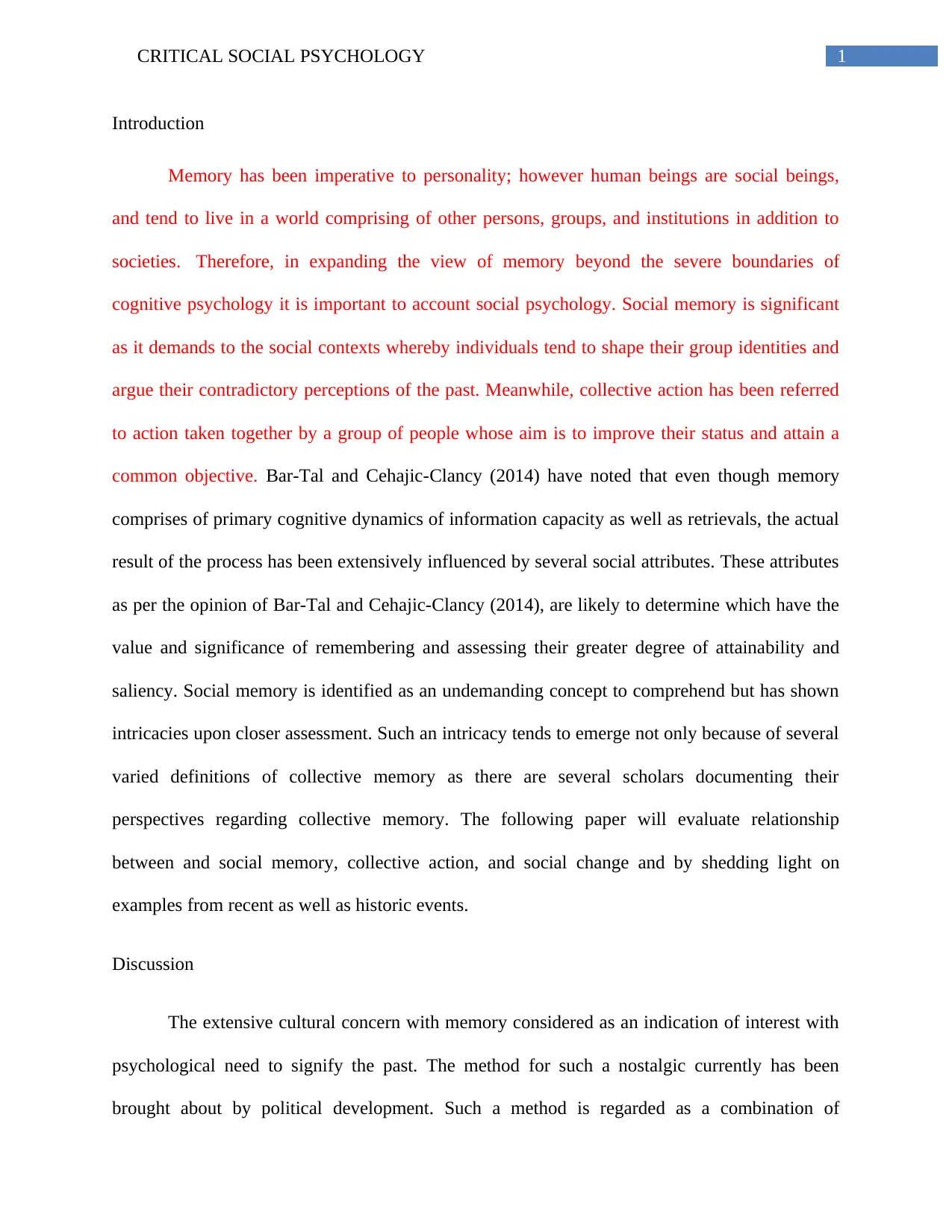
1CRITICAL SOCIAL PSYCHOLOGY
Introduction
Memory has been imperative to personality; however human beings are social beings,
and tend to live in a world comprising of other persons, groups, and institutions in addition to
societies. Therefore, in expanding the view of memory beyond the severe boundaries of
cognitive psychology it is important to account social psychology. Social memory is significant
as it demands to the social contexts whereby individuals tend to shape their group identities and
argue their contradictory perceptions of the past. Meanwhile, collective action has been referred
to action taken together by a group of people whose aim is to improve their status and attain a
common objective. Bar-Tal and Cehajic-Clancy (2014) have noted that even though memory
comprises of primary cognitive dynamics of information capacity as well as retrievals, the actual
result of the process has been extensively influenced by several social attributes. These attributes
as per the opinion of Bar-Tal and Cehajic-Clancy (2014), are likely to determine which have the
value and significance of remembering and assessing their greater degree of attainability and
saliency. Social memory is identified as an undemanding concept to comprehend but has shown
intricacies upon closer assessment. Such an intricacy tends to emerge not only because of several
varied definitions of collective memory as there are several scholars documenting their
perspectives regarding collective memory. The following paper will evaluate relationship
between and social memory, collective action, and social change and by shedding light on
examples from recent as well as historic events.
Discussion
The extensive cultural concern with memory considered as an indication of interest with
psychological need to signify the past. The method for such a nostalgic currently has been
brought about by political development. Such a method is regarded as a combination of
Introduction
Memory has been imperative to personality; however human beings are social beings,
and tend to live in a world comprising of other persons, groups, and institutions in addition to
societies. Therefore, in expanding the view of memory beyond the severe boundaries of
cognitive psychology it is important to account social psychology. Social memory is significant
as it demands to the social contexts whereby individuals tend to shape their group identities and
argue their contradictory perceptions of the past. Meanwhile, collective action has been referred
to action taken together by a group of people whose aim is to improve their status and attain a
common objective. Bar-Tal and Cehajic-Clancy (2014) have noted that even though memory
comprises of primary cognitive dynamics of information capacity as well as retrievals, the actual
result of the process has been extensively influenced by several social attributes. These attributes
as per the opinion of Bar-Tal and Cehajic-Clancy (2014), are likely to determine which have the
value and significance of remembering and assessing their greater degree of attainability and
saliency. Social memory is identified as an undemanding concept to comprehend but has shown
intricacies upon closer assessment. Such an intricacy tends to emerge not only because of several
varied definitions of collective memory as there are several scholars documenting their
perspectives regarding collective memory. The following paper will evaluate relationship
between and social memory, collective action, and social change and by shedding light on
examples from recent as well as historic events.
Discussion
The extensive cultural concern with memory considered as an indication of interest with
psychological need to signify the past. The method for such a nostalgic currently has been
brought about by political development. Such a method is regarded as a combination of
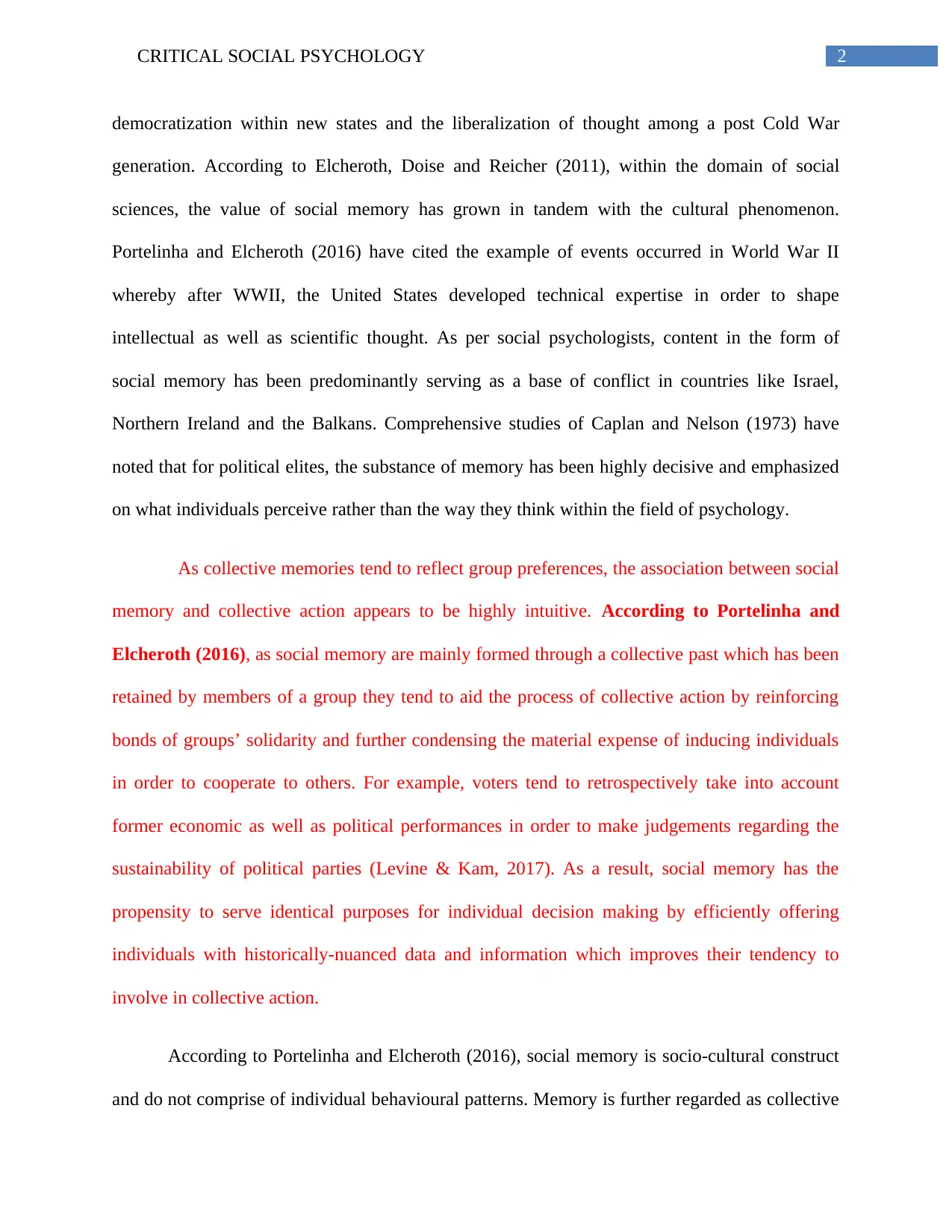
2CRITICAL SOCIAL PSYCHOLOGY
democratization within new states and the liberalization of thought among a post Cold War
generation. According to Elcheroth, Doise and Reicher (2011), within the domain of social
sciences, the value of social memory has grown in tandem with the cultural phenomenon.
Portelinha and Elcheroth (2016) have cited the example of events occurred in World War II
whereby after WWII, the United States developed technical expertise in order to shape
intellectual as well as scientific thought. As per social psychologists, content in the form of
social memory has been predominantly serving as a base of conflict in countries like Israel,
Northern Ireland and the Balkans. Comprehensive studies of Caplan and Nelson (1973) have
noted that for political elites, the substance of memory has been highly decisive and emphasized
on what individuals perceive rather than the way they think within the field of psychology.
As collective memories tend to reflect group preferences, the association between social
memory and collective action appears to be highly intuitive. According to Portelinha and
Elcheroth (2016), as social memory are mainly formed through a collective past which has been
retained by members of a group they tend to aid the process of collective action by reinforcing
bonds of groups’ solidarity and further condensing the material expense of inducing individuals
in order to cooperate to others. For example, voters tend to retrospectively take into account
former economic as well as political performances in order to make judgements regarding the
sustainability of political parties (Levine & Kam, 2017). As a result, social memory has the
propensity to serve identical purposes for individual decision making by efficiently offering
individuals with historically-nuanced data and information which improves their tendency to
involve in collective action.
According to Portelinha and Elcheroth (2016), social memory is socio-cultural construct
and do not comprise of individual behavioural patterns. Memory is further regarded as collective
democratization within new states and the liberalization of thought among a post Cold War
generation. According to Elcheroth, Doise and Reicher (2011), within the domain of social
sciences, the value of social memory has grown in tandem with the cultural phenomenon.
Portelinha and Elcheroth (2016) have cited the example of events occurred in World War II
whereby after WWII, the United States developed technical expertise in order to shape
intellectual as well as scientific thought. As per social psychologists, content in the form of
social memory has been predominantly serving as a base of conflict in countries like Israel,
Northern Ireland and the Balkans. Comprehensive studies of Caplan and Nelson (1973) have
noted that for political elites, the substance of memory has been highly decisive and emphasized
on what individuals perceive rather than the way they think within the field of psychology.
As collective memories tend to reflect group preferences, the association between social
memory and collective action appears to be highly intuitive. According to Portelinha and
Elcheroth (2016), as social memory are mainly formed through a collective past which has been
retained by members of a group they tend to aid the process of collective action by reinforcing
bonds of groups’ solidarity and further condensing the material expense of inducing individuals
in order to cooperate to others. For example, voters tend to retrospectively take into account
former economic as well as political performances in order to make judgements regarding the
sustainability of political parties (Levine & Kam, 2017). As a result, social memory has the
propensity to serve identical purposes for individual decision making by efficiently offering
individuals with historically-nuanced data and information which improves their tendency to
involve in collective action.
According to Portelinha and Elcheroth (2016), social memory is socio-cultural construct
and do not comprise of individual behavioural patterns. Memory is further regarded as collective
⊘ This is a preview!⊘
Do you want full access?
Subscribe today to unlock all pages.

Trusted by 1+ million students worldwide
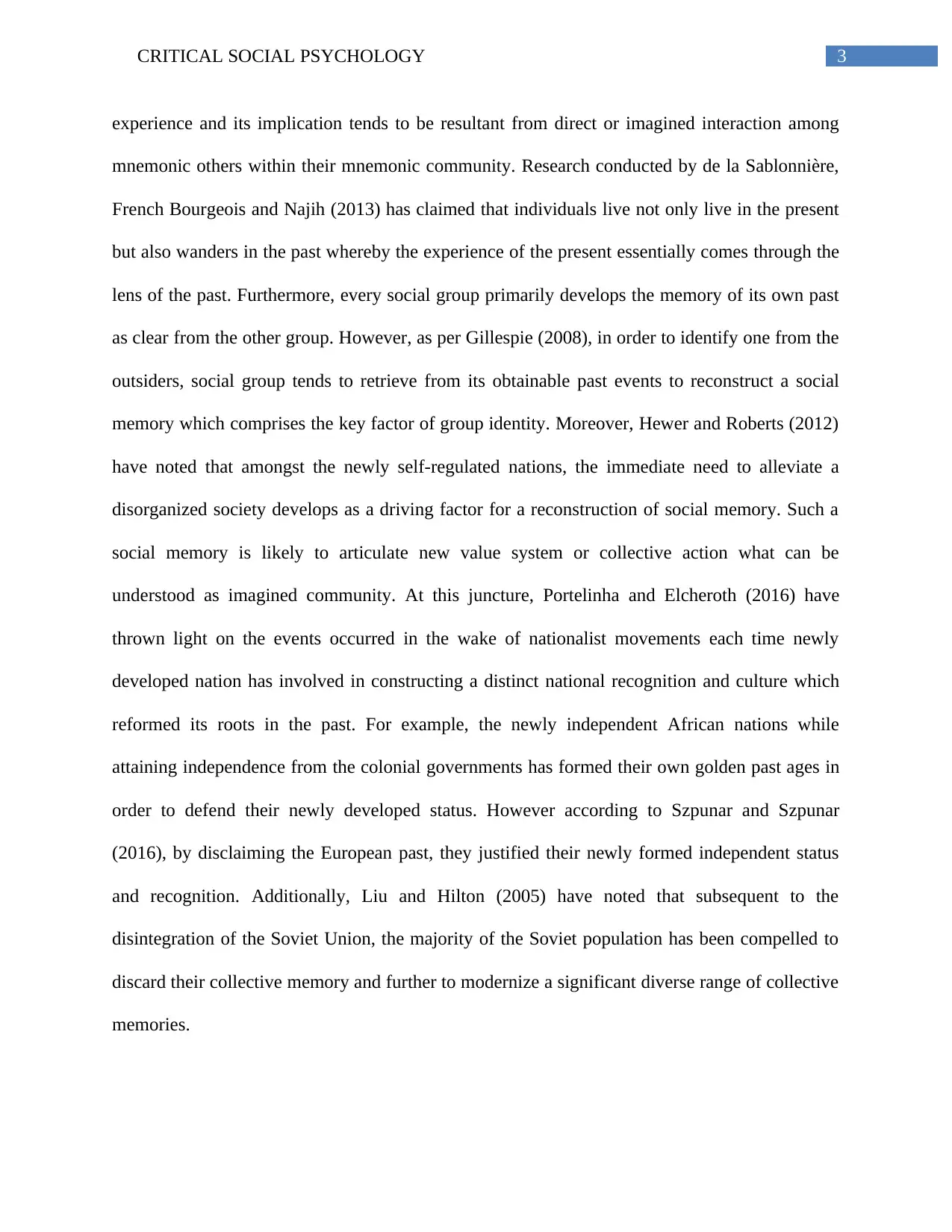
3CRITICAL SOCIAL PSYCHOLOGY
experience and its implication tends to be resultant from direct or imagined interaction among
mnemonic others within their mnemonic community. Research conducted by de la Sablonnière,
French Bourgeois and Najih (2013) has claimed that individuals live not only live in the present
but also wanders in the past whereby the experience of the present essentially comes through the
lens of the past. Furthermore, every social group primarily develops the memory of its own past
as clear from the other group. However, as per Gillespie (2008), in order to identify one from the
outsiders, social group tends to retrieve from its obtainable past events to reconstruct a social
memory which comprises the key factor of group identity. Moreover, Hewer and Roberts (2012)
have noted that amongst the newly self-regulated nations, the immediate need to alleviate a
disorganized society develops as a driving factor for a reconstruction of social memory. Such a
social memory is likely to articulate new value system or collective action what can be
understood as imagined community. At this juncture, Portelinha and Elcheroth (2016) have
thrown light on the events occurred in the wake of nationalist movements each time newly
developed nation has involved in constructing a distinct national recognition and culture which
reformed its roots in the past. For example, the newly independent African nations while
attaining independence from the colonial governments has formed their own golden past ages in
order to defend their newly developed status. However according to Szpunar and Szpunar
(2016), by disclaiming the European past, they justified their newly formed independent status
and recognition. Additionally, Liu and Hilton (2005) have noted that subsequent to the
disintegration of the Soviet Union, the majority of the Soviet population has been compelled to
discard their collective memory and further to modernize a significant diverse range of collective
memories.
experience and its implication tends to be resultant from direct or imagined interaction among
mnemonic others within their mnemonic community. Research conducted by de la Sablonnière,
French Bourgeois and Najih (2013) has claimed that individuals live not only live in the present
but also wanders in the past whereby the experience of the present essentially comes through the
lens of the past. Furthermore, every social group primarily develops the memory of its own past
as clear from the other group. However, as per Gillespie (2008), in order to identify one from the
outsiders, social group tends to retrieve from its obtainable past events to reconstruct a social
memory which comprises the key factor of group identity. Moreover, Hewer and Roberts (2012)
have noted that amongst the newly self-regulated nations, the immediate need to alleviate a
disorganized society develops as a driving factor for a reconstruction of social memory. Such a
social memory is likely to articulate new value system or collective action what can be
understood as imagined community. At this juncture, Portelinha and Elcheroth (2016) have
thrown light on the events occurred in the wake of nationalist movements each time newly
developed nation has involved in constructing a distinct national recognition and culture which
reformed its roots in the past. For example, the newly independent African nations while
attaining independence from the colonial governments has formed their own golden past ages in
order to defend their newly developed status. However according to Szpunar and Szpunar
(2016), by disclaiming the European past, they justified their newly formed independent status
and recognition. Additionally, Liu and Hilton (2005) have noted that subsequent to the
disintegration of the Soviet Union, the majority of the Soviet population has been compelled to
discard their collective memory and further to modernize a significant diverse range of collective
memories.
Paraphrase This Document
Need a fresh take? Get an instant paraphrase of this document with our AI Paraphraser
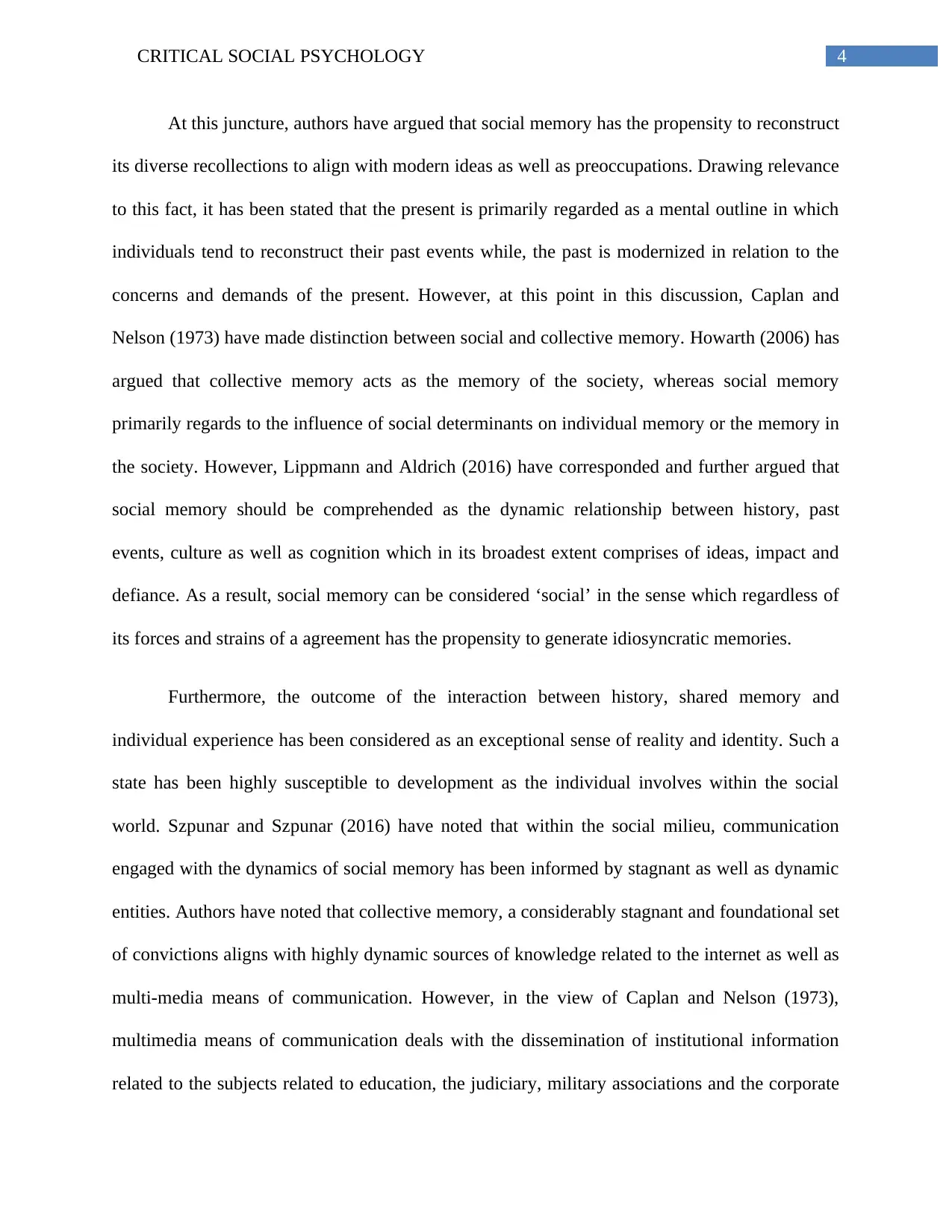
4CRITICAL SOCIAL PSYCHOLOGY
At this juncture, authors have argued that social memory has the propensity to reconstruct
its diverse recollections to align with modern ideas as well as preoccupations. Drawing relevance
to this fact, it has been stated that the present is primarily regarded as a mental outline in which
individuals tend to reconstruct their past events while, the past is modernized in relation to the
concerns and demands of the present. However, at this point in this discussion, Caplan and
Nelson (1973) have made distinction between social and collective memory. Howarth (2006) has
argued that collective memory acts as the memory of the society, whereas social memory
primarily regards to the influence of social determinants on individual memory or the memory in
the society. However, Lippmann and Aldrich (2016) have corresponded and further argued that
social memory should be comprehended as the dynamic relationship between history, past
events, culture as well as cognition which in its broadest extent comprises of ideas, impact and
defiance. As a result, social memory can be considered ‘social’ in the sense which regardless of
its forces and strains of a agreement has the propensity to generate idiosyncratic memories.
Furthermore, the outcome of the interaction between history, shared memory and
individual experience has been considered as an exceptional sense of reality and identity. Such a
state has been highly susceptible to development as the individual involves within the social
world. Szpunar and Szpunar (2016) have noted that within the social milieu, communication
engaged with the dynamics of social memory has been informed by stagnant as well as dynamic
entities. Authors have noted that collective memory, a considerably stagnant and foundational set
of convictions aligns with highly dynamic sources of knowledge related to the internet as well as
multi-media means of communication. However, in the view of Caplan and Nelson (1973),
multimedia means of communication deals with the dissemination of institutional information
related to the subjects related to education, the judiciary, military associations and the corporate
At this juncture, authors have argued that social memory has the propensity to reconstruct
its diverse recollections to align with modern ideas as well as preoccupations. Drawing relevance
to this fact, it has been stated that the present is primarily regarded as a mental outline in which
individuals tend to reconstruct their past events while, the past is modernized in relation to the
concerns and demands of the present. However, at this point in this discussion, Caplan and
Nelson (1973) have made distinction between social and collective memory. Howarth (2006) has
argued that collective memory acts as the memory of the society, whereas social memory
primarily regards to the influence of social determinants on individual memory or the memory in
the society. However, Lippmann and Aldrich (2016) have corresponded and further argued that
social memory should be comprehended as the dynamic relationship between history, past
events, culture as well as cognition which in its broadest extent comprises of ideas, impact and
defiance. As a result, social memory can be considered ‘social’ in the sense which regardless of
its forces and strains of a agreement has the propensity to generate idiosyncratic memories.
Furthermore, the outcome of the interaction between history, shared memory and
individual experience has been considered as an exceptional sense of reality and identity. Such a
state has been highly susceptible to development as the individual involves within the social
world. Szpunar and Szpunar (2016) have noted that within the social milieu, communication
engaged with the dynamics of social memory has been informed by stagnant as well as dynamic
entities. Authors have noted that collective memory, a considerably stagnant and foundational set
of convictions aligns with highly dynamic sources of knowledge related to the internet as well as
multi-media means of communication. However, in the view of Caplan and Nelson (1973),
multimedia means of communication deals with the dissemination of institutional information
related to the subjects related to education, the judiciary, military associations and the corporate
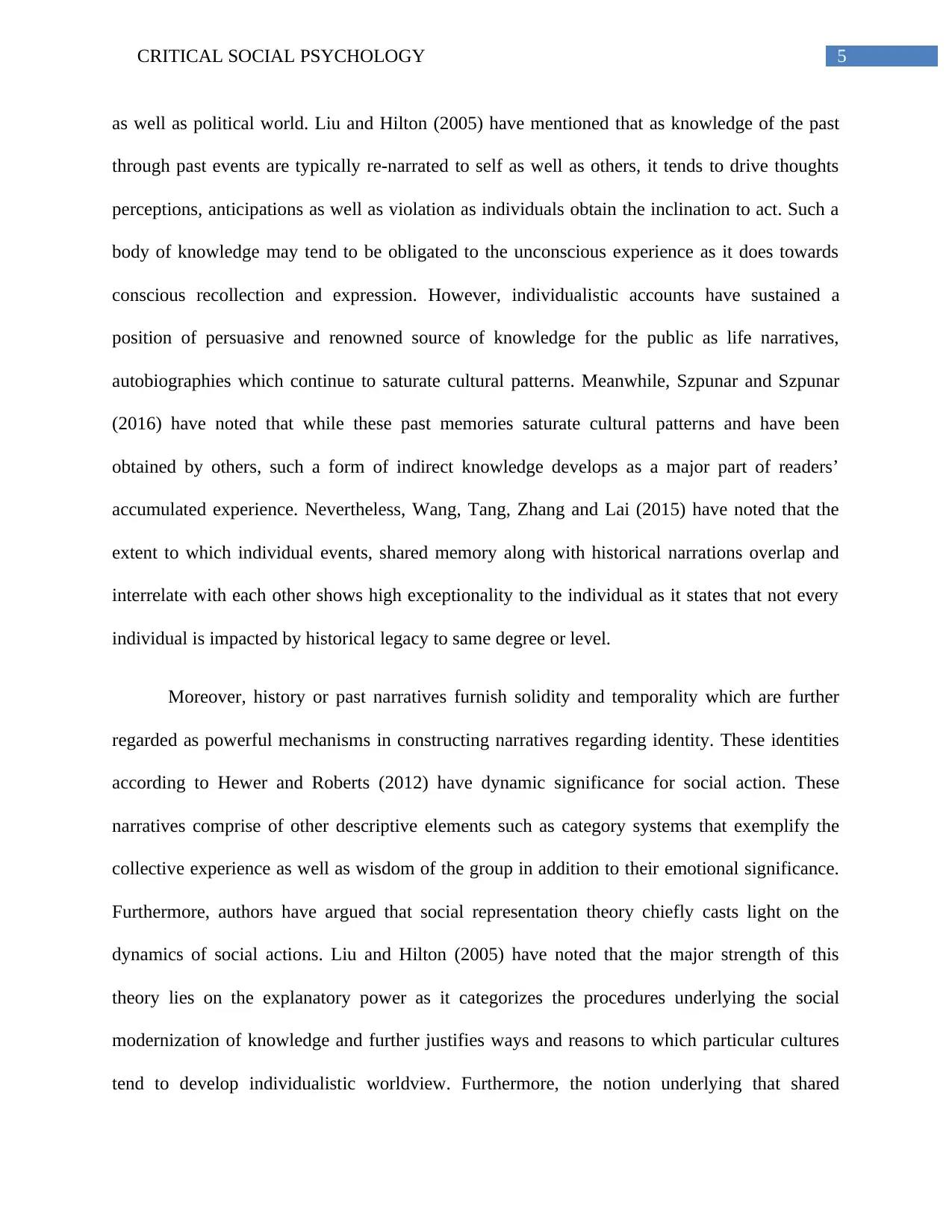
5CRITICAL SOCIAL PSYCHOLOGY
as well as political world. Liu and Hilton (2005) have mentioned that as knowledge of the past
through past events are typically re-narrated to self as well as others, it tends to drive thoughts
perceptions, anticipations as well as violation as individuals obtain the inclination to act. Such a
body of knowledge may tend to be obligated to the unconscious experience as it does towards
conscious recollection and expression. However, individualistic accounts have sustained a
position of persuasive and renowned source of knowledge for the public as life narratives,
autobiographies which continue to saturate cultural patterns. Meanwhile, Szpunar and Szpunar
(2016) have noted that while these past memories saturate cultural patterns and have been
obtained by others, such a form of indirect knowledge develops as a major part of readers’
accumulated experience. Nevertheless, Wang, Tang, Zhang and Lai (2015) have noted that the
extent to which individual events, shared memory along with historical narrations overlap and
interrelate with each other shows high exceptionality to the individual as it states that not every
individual is impacted by historical legacy to same degree or level.
Moreover, history or past narratives furnish solidity and temporality which are further
regarded as powerful mechanisms in constructing narratives regarding identity. These identities
according to Hewer and Roberts (2012) have dynamic significance for social action. These
narratives comprise of other descriptive elements such as category systems that exemplify the
collective experience as well as wisdom of the group in addition to their emotional significance.
Furthermore, authors have argued that social representation theory chiefly casts light on the
dynamics of social actions. Liu and Hilton (2005) have noted that the major strength of this
theory lies on the explanatory power as it categorizes the procedures underlying the social
modernization of knowledge and further justifies ways and reasons to which particular cultures
tend to develop individualistic worldview. Furthermore, the notion underlying that shared
as well as political world. Liu and Hilton (2005) have mentioned that as knowledge of the past
through past events are typically re-narrated to self as well as others, it tends to drive thoughts
perceptions, anticipations as well as violation as individuals obtain the inclination to act. Such a
body of knowledge may tend to be obligated to the unconscious experience as it does towards
conscious recollection and expression. However, individualistic accounts have sustained a
position of persuasive and renowned source of knowledge for the public as life narratives,
autobiographies which continue to saturate cultural patterns. Meanwhile, Szpunar and Szpunar
(2016) have noted that while these past memories saturate cultural patterns and have been
obtained by others, such a form of indirect knowledge develops as a major part of readers’
accumulated experience. Nevertheless, Wang, Tang, Zhang and Lai (2015) have noted that the
extent to which individual events, shared memory along with historical narrations overlap and
interrelate with each other shows high exceptionality to the individual as it states that not every
individual is impacted by historical legacy to same degree or level.
Moreover, history or past narratives furnish solidity and temporality which are further
regarded as powerful mechanisms in constructing narratives regarding identity. These identities
according to Hewer and Roberts (2012) have dynamic significance for social action. These
narratives comprise of other descriptive elements such as category systems that exemplify the
collective experience as well as wisdom of the group in addition to their emotional significance.
Furthermore, authors have argued that social representation theory chiefly casts light on the
dynamics of social actions. Liu and Hilton (2005) have noted that the major strength of this
theory lies on the explanatory power as it categorizes the procedures underlying the social
modernization of knowledge and further justifies ways and reasons to which particular cultures
tend to develop individualistic worldview. Furthermore, the notion underlying that shared
⊘ This is a preview!⊘
Do you want full access?
Subscribe today to unlock all pages.

Trusted by 1+ million students worldwide
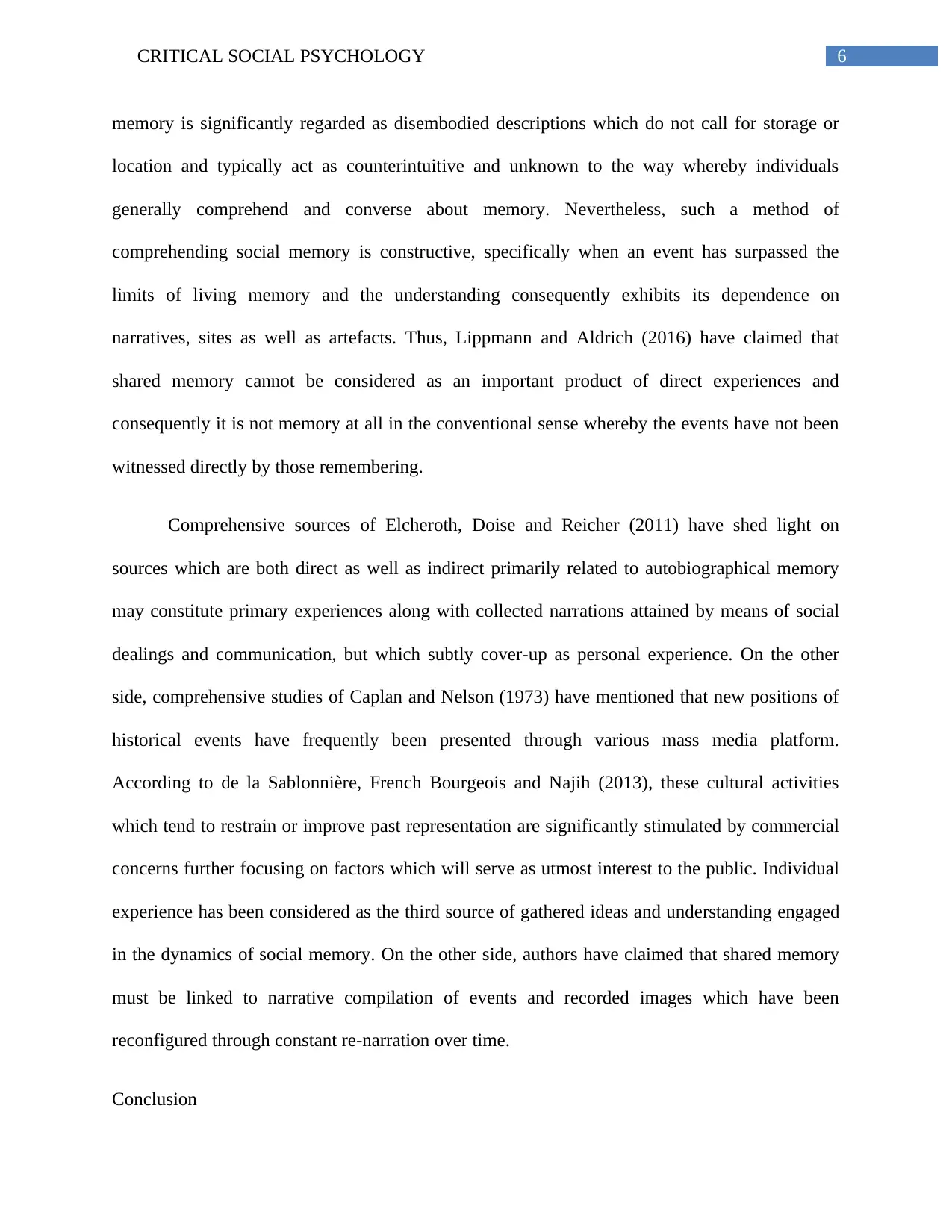
6CRITICAL SOCIAL PSYCHOLOGY
memory is significantly regarded as disembodied descriptions which do not call for storage or
location and typically act as counterintuitive and unknown to the way whereby individuals
generally comprehend and converse about memory. Nevertheless, such a method of
comprehending social memory is constructive, specifically when an event has surpassed the
limits of living memory and the understanding consequently exhibits its dependence on
narratives, sites as well as artefacts. Thus, Lippmann and Aldrich (2016) have claimed that
shared memory cannot be considered as an important product of direct experiences and
consequently it is not memory at all in the conventional sense whereby the events have not been
witnessed directly by those remembering.
Comprehensive sources of Elcheroth, Doise and Reicher (2011) have shed light on
sources which are both direct as well as indirect primarily related to autobiographical memory
may constitute primary experiences along with collected narrations attained by means of social
dealings and communication, but which subtly cover-up as personal experience. On the other
side, comprehensive studies of Caplan and Nelson (1973) have mentioned that new positions of
historical events have frequently been presented through various mass media platform.
According to de la Sablonnière, French Bourgeois and Najih (2013), these cultural activities
which tend to restrain or improve past representation are significantly stimulated by commercial
concerns further focusing on factors which will serve as utmost interest to the public. Individual
experience has been considered as the third source of gathered ideas and understanding engaged
in the dynamics of social memory. On the other side, authors have claimed that shared memory
must be linked to narrative compilation of events and recorded images which have been
reconfigured through constant re-narration over time.
Conclusion
memory is significantly regarded as disembodied descriptions which do not call for storage or
location and typically act as counterintuitive and unknown to the way whereby individuals
generally comprehend and converse about memory. Nevertheless, such a method of
comprehending social memory is constructive, specifically when an event has surpassed the
limits of living memory and the understanding consequently exhibits its dependence on
narratives, sites as well as artefacts. Thus, Lippmann and Aldrich (2016) have claimed that
shared memory cannot be considered as an important product of direct experiences and
consequently it is not memory at all in the conventional sense whereby the events have not been
witnessed directly by those remembering.
Comprehensive sources of Elcheroth, Doise and Reicher (2011) have shed light on
sources which are both direct as well as indirect primarily related to autobiographical memory
may constitute primary experiences along with collected narrations attained by means of social
dealings and communication, but which subtly cover-up as personal experience. On the other
side, comprehensive studies of Caplan and Nelson (1973) have mentioned that new positions of
historical events have frequently been presented through various mass media platform.
According to de la Sablonnière, French Bourgeois and Najih (2013), these cultural activities
which tend to restrain or improve past representation are significantly stimulated by commercial
concerns further focusing on factors which will serve as utmost interest to the public. Individual
experience has been considered as the third source of gathered ideas and understanding engaged
in the dynamics of social memory. On the other side, authors have claimed that shared memory
must be linked to narrative compilation of events and recorded images which have been
reconfigured through constant re-narration over time.
Conclusion
Paraphrase This Document
Need a fresh take? Get an instant paraphrase of this document with our AI Paraphraser
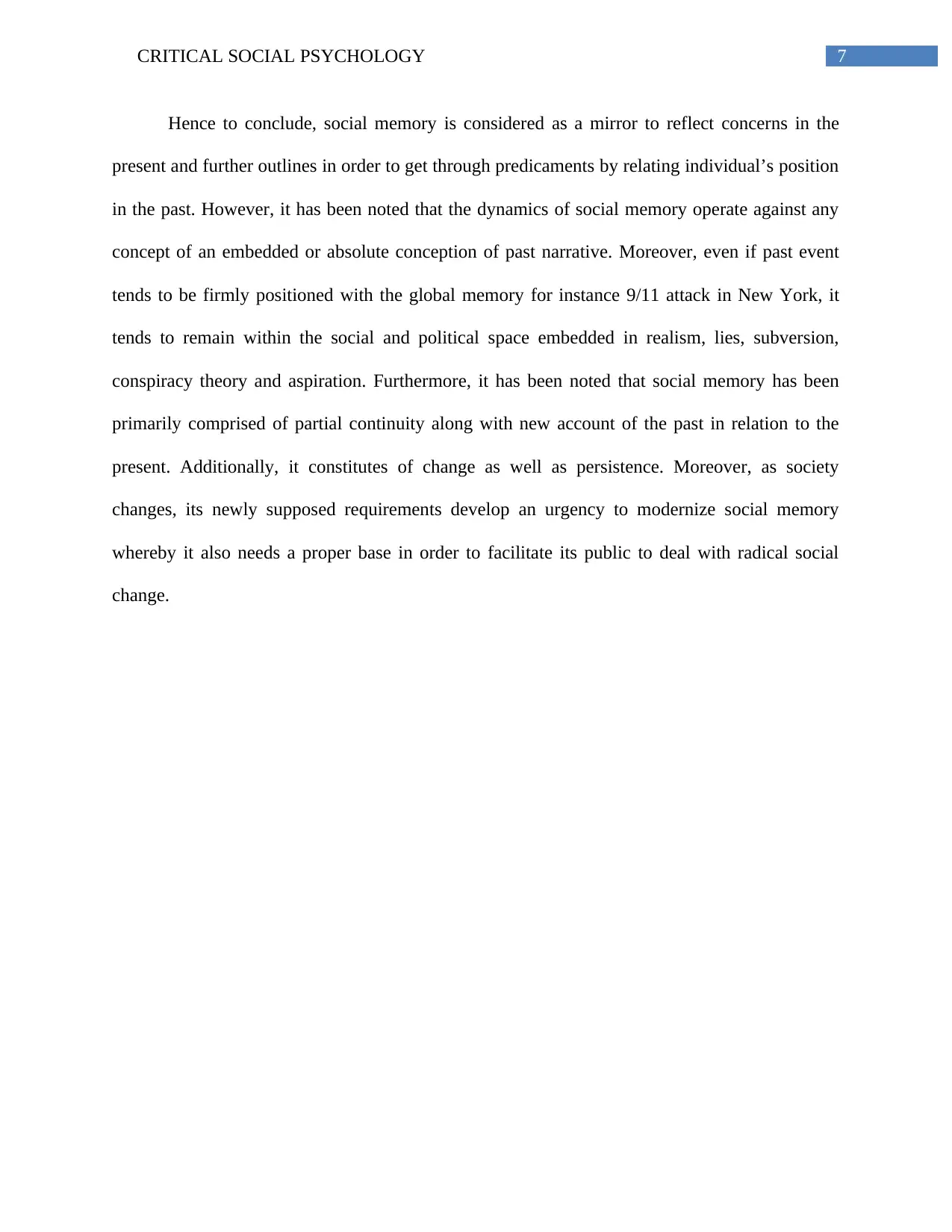
7CRITICAL SOCIAL PSYCHOLOGY
Hence to conclude, social memory is considered as a mirror to reflect concerns in the
present and further outlines in order to get through predicaments by relating individual’s position
in the past. However, it has been noted that the dynamics of social memory operate against any
concept of an embedded or absolute conception of past narrative. Moreover, even if past event
tends to be firmly positioned with the global memory for instance 9/11 attack in New York, it
tends to remain within the social and political space embedded in realism, lies, subversion,
conspiracy theory and aspiration. Furthermore, it has been noted that social memory has been
primarily comprised of partial continuity along with new account of the past in relation to the
present. Additionally, it constitutes of change as well as persistence. Moreover, as society
changes, its newly supposed requirements develop an urgency to modernize social memory
whereby it also needs a proper base in order to facilitate its public to deal with radical social
change.
Hence to conclude, social memory is considered as a mirror to reflect concerns in the
present and further outlines in order to get through predicaments by relating individual’s position
in the past. However, it has been noted that the dynamics of social memory operate against any
concept of an embedded or absolute conception of past narrative. Moreover, even if past event
tends to be firmly positioned with the global memory for instance 9/11 attack in New York, it
tends to remain within the social and political space embedded in realism, lies, subversion,
conspiracy theory and aspiration. Furthermore, it has been noted that social memory has been
primarily comprised of partial continuity along with new account of the past in relation to the
present. Additionally, it constitutes of change as well as persistence. Moreover, as society
changes, its newly supposed requirements develop an urgency to modernize social memory
whereby it also needs a proper base in order to facilitate its public to deal with radical social
change.
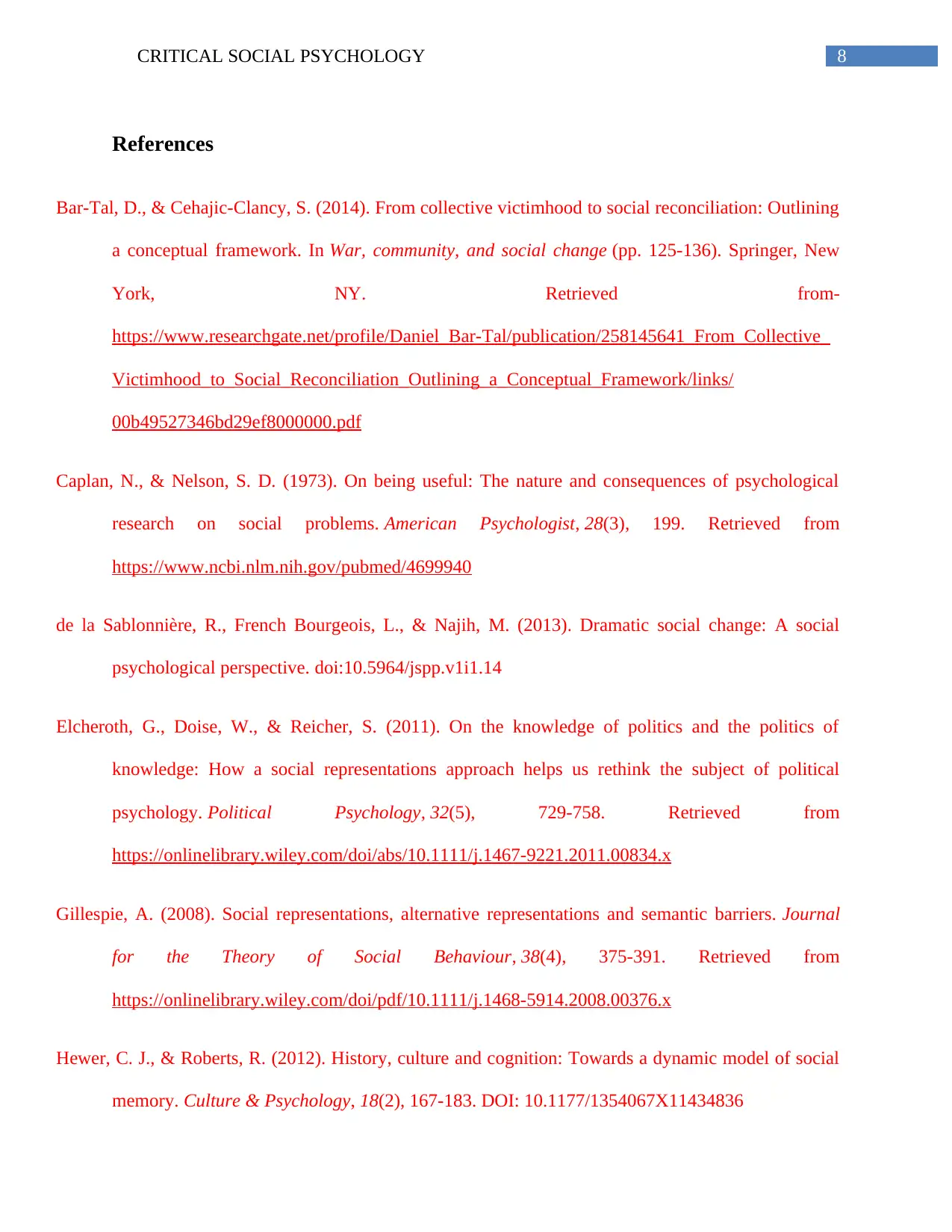
8CRITICAL SOCIAL PSYCHOLOGY
References
Bar-Tal, D., & Cehajic-Clancy, S. (2014). From collective victimhood to social reconciliation: Outlining
a conceptual framework. In War, community, and social change (pp. 125-136). Springer, New
York, NY. Retrieved from-
https://www.researchgate.net/profile/Daniel_Bar-Tal/publication/258145641_From_Collective_
Victimhood_to_Social_Reconciliation_Outlining_a_Conceptual_Framework/links/
00b49527346bd29ef8000000.pdf
Caplan, N., & Nelson, S. D. (1973). On being useful: The nature and consequences of psychological
research on social problems. American Psychologist, 28(3), 199. Retrieved from
https://www.ncbi.nlm.nih.gov/pubmed/4699940
de la Sablonnière, R., French Bourgeois, L., & Najih, M. (2013). Dramatic social change: A social
psychological perspective. doi:10.5964/jspp.v1i1.14
Elcheroth, G., Doise, W., & Reicher, S. (2011). On the knowledge of politics and the politics of
knowledge: How a social representations approach helps us rethink the subject of political
psychology. Political Psychology, 32(5), 729-758. Retrieved from
https://onlinelibrary.wiley.com/doi/abs/10.1111/j.1467-9221.2011.00834.x
Gillespie, A. (2008). Social representations, alternative representations and semantic barriers. Journal
for the Theory of Social Behaviour, 38(4), 375-391. Retrieved from
https://onlinelibrary.wiley.com/doi/pdf/10.1111/j.1468-5914.2008.00376.x
Hewer, C. J., & Roberts, R. (2012). History, culture and cognition: Towards a dynamic model of social
memory. Culture & Psychology, 18(2), 167-183. DOI: 10.1177/1354067X11434836
References
Bar-Tal, D., & Cehajic-Clancy, S. (2014). From collective victimhood to social reconciliation: Outlining
a conceptual framework. In War, community, and social change (pp. 125-136). Springer, New
York, NY. Retrieved from-
https://www.researchgate.net/profile/Daniel_Bar-Tal/publication/258145641_From_Collective_
Victimhood_to_Social_Reconciliation_Outlining_a_Conceptual_Framework/links/
00b49527346bd29ef8000000.pdf
Caplan, N., & Nelson, S. D. (1973). On being useful: The nature and consequences of psychological
research on social problems. American Psychologist, 28(3), 199. Retrieved from
https://www.ncbi.nlm.nih.gov/pubmed/4699940
de la Sablonnière, R., French Bourgeois, L., & Najih, M. (2013). Dramatic social change: A social
psychological perspective. doi:10.5964/jspp.v1i1.14
Elcheroth, G., Doise, W., & Reicher, S. (2011). On the knowledge of politics and the politics of
knowledge: How a social representations approach helps us rethink the subject of political
psychology. Political Psychology, 32(5), 729-758. Retrieved from
https://onlinelibrary.wiley.com/doi/abs/10.1111/j.1467-9221.2011.00834.x
Gillespie, A. (2008). Social representations, alternative representations and semantic barriers. Journal
for the Theory of Social Behaviour, 38(4), 375-391. Retrieved from
https://onlinelibrary.wiley.com/doi/pdf/10.1111/j.1468-5914.2008.00376.x
Hewer, C. J., & Roberts, R. (2012). History, culture and cognition: Towards a dynamic model of social
memory. Culture & Psychology, 18(2), 167-183. DOI: 10.1177/1354067X11434836
⊘ This is a preview!⊘
Do you want full access?
Subscribe today to unlock all pages.

Trusted by 1+ million students worldwide
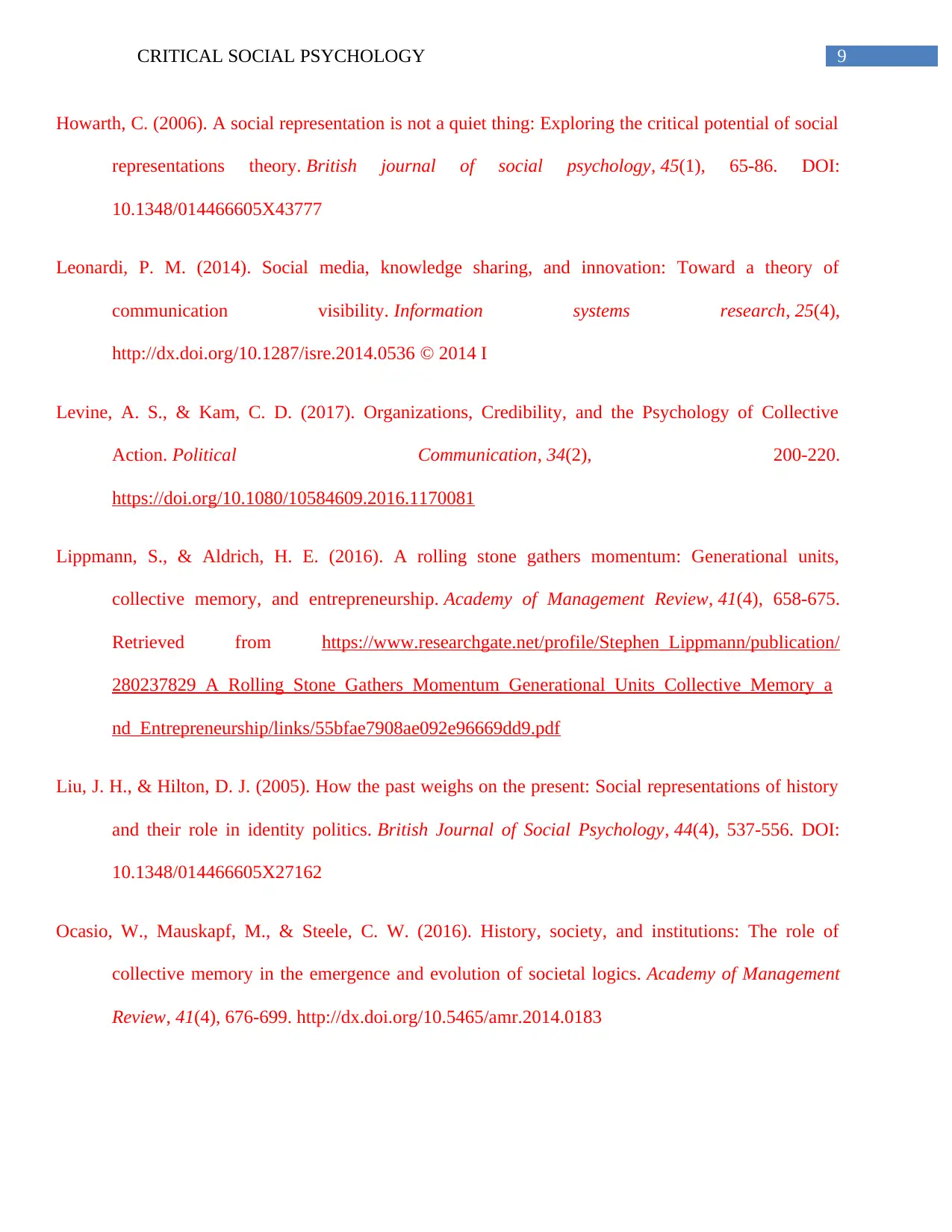
9CRITICAL SOCIAL PSYCHOLOGY
Howarth, C. (2006). A social representation is not a quiet thing: Exploring the critical potential of social
representations theory. British journal of social psychology, 45(1), 65-86. DOI:
10.1348/014466605X43777
Leonardi, P. M. (2014). Social media, knowledge sharing, and innovation: Toward a theory of
communication visibility. Information systems research, 25(4),
http://dx.doi.org/10.1287/isre.2014.0536 © 2014 I
Levine, A. S., & Kam, C. D. (2017). Organizations, Credibility, and the Psychology of Collective
Action. Political Communication, 34(2), 200-220.
https://doi.org/10.1080/10584609.2016.1170081
Lippmann, S., & Aldrich, H. E. (2016). A rolling stone gathers momentum: Generational units,
collective memory, and entrepreneurship. Academy of Management Review, 41(4), 658-675.
Retrieved from https://www.researchgate.net/profile/Stephen_Lippmann/publication/
280237829_A_Rolling_Stone_Gathers_Momentum_Generational_Units_Collective_Memory_a
nd_Entrepreneurship/links/55bfae7908ae092e96669dd9.pdf
Liu, J. H., & Hilton, D. J. (2005). How the past weighs on the present: Social representations of history
and their role in identity politics. British Journal of Social Psychology, 44(4), 537-556. DOI:
10.1348/014466605X27162
Ocasio, W., Mauskapf, M., & Steele, C. W. (2016). History, society, and institutions: The role of
collective memory in the emergence and evolution of societal logics. Academy of Management
Review, 41(4), 676-699. http://dx.doi.org/10.5465/amr.2014.0183
Howarth, C. (2006). A social representation is not a quiet thing: Exploring the critical potential of social
representations theory. British journal of social psychology, 45(1), 65-86. DOI:
10.1348/014466605X43777
Leonardi, P. M. (2014). Social media, knowledge sharing, and innovation: Toward a theory of
communication visibility. Information systems research, 25(4),
http://dx.doi.org/10.1287/isre.2014.0536 © 2014 I
Levine, A. S., & Kam, C. D. (2017). Organizations, Credibility, and the Psychology of Collective
Action. Political Communication, 34(2), 200-220.
https://doi.org/10.1080/10584609.2016.1170081
Lippmann, S., & Aldrich, H. E. (2016). A rolling stone gathers momentum: Generational units,
collective memory, and entrepreneurship. Academy of Management Review, 41(4), 658-675.
Retrieved from https://www.researchgate.net/profile/Stephen_Lippmann/publication/
280237829_A_Rolling_Stone_Gathers_Momentum_Generational_Units_Collective_Memory_a
nd_Entrepreneurship/links/55bfae7908ae092e96669dd9.pdf
Liu, J. H., & Hilton, D. J. (2005). How the past weighs on the present: Social representations of history
and their role in identity politics. British Journal of Social Psychology, 44(4), 537-556. DOI:
10.1348/014466605X27162
Ocasio, W., Mauskapf, M., & Steele, C. W. (2016). History, society, and institutions: The role of
collective memory in the emergence and evolution of societal logics. Academy of Management
Review, 41(4), 676-699. http://dx.doi.org/10.5465/amr.2014.0183
Paraphrase This Document
Need a fresh take? Get an instant paraphrase of this document with our AI Paraphraser
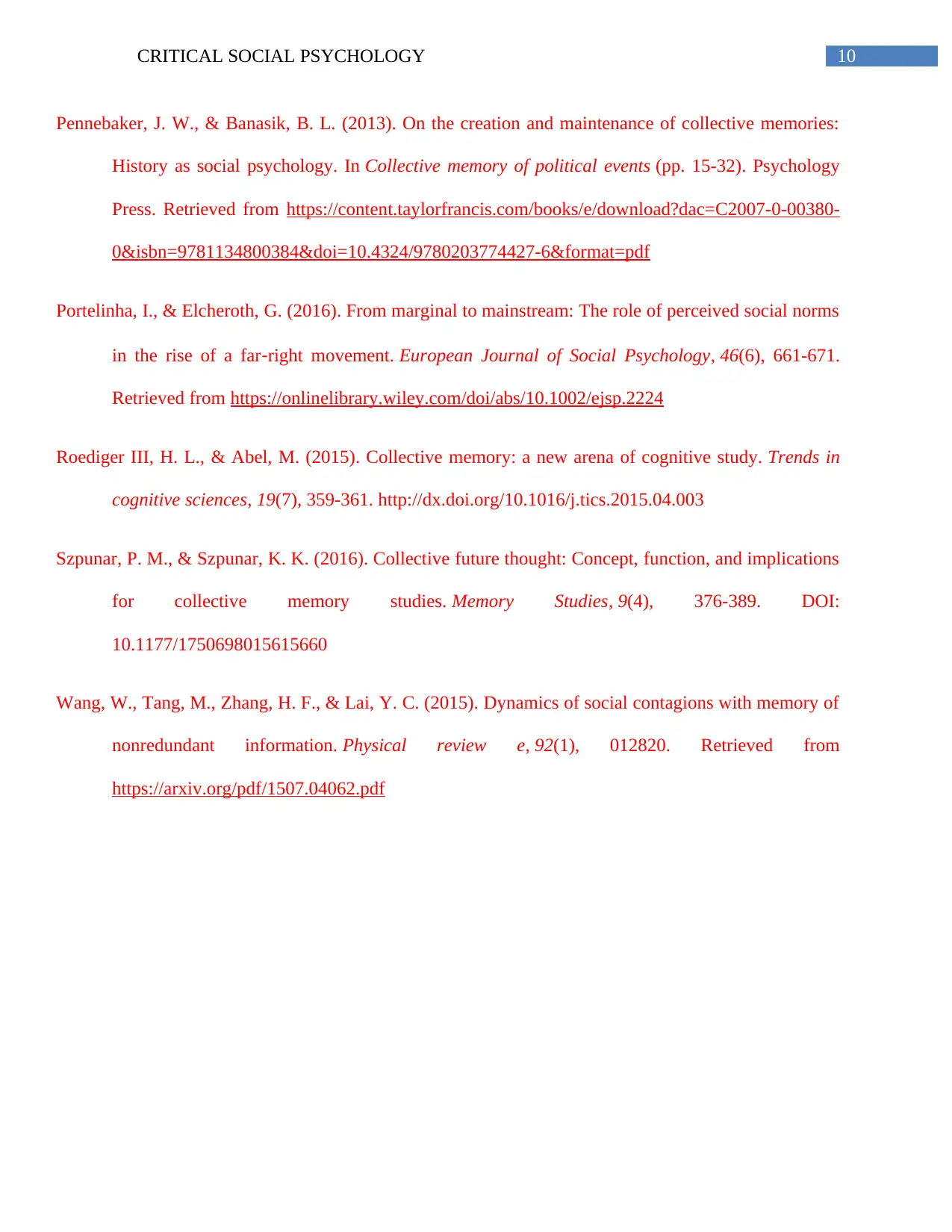
10CRITICAL SOCIAL PSYCHOLOGY
Pennebaker, J. W., & Banasik, B. L. (2013). On the creation and maintenance of collective memories:
History as social psychology. In Collective memory of political events (pp. 15-32). Psychology
Press. Retrieved from https://content.taylorfrancis.com/books/e/download?dac=C2007-0-00380-
0&isbn=9781134800384&doi=10.4324/9780203774427-6&format=pdf
Portelinha, I., & Elcheroth, G. (2016). From marginal to mainstream: The role of perceived social norms
in the rise of a far‐right movement. European Journal of Social Psychology, 46(6), 661-671.
Retrieved from https://onlinelibrary.wiley.com/doi/abs/10.1002/ejsp.2224
Roediger III, H. L., & Abel, M. (2015). Collective memory: a new arena of cognitive study. Trends in
cognitive sciences, 19(7), 359-361. http://dx.doi.org/10.1016/j.tics.2015.04.003
Szpunar, P. M., & Szpunar, K. K. (2016). Collective future thought: Concept, function, and implications
for collective memory studies. Memory Studies, 9(4), 376-389. DOI:
10.1177/1750698015615660
Wang, W., Tang, M., Zhang, H. F., & Lai, Y. C. (2015). Dynamics of social contagions with memory of
nonredundant information. Physical review e, 92(1), 012820. Retrieved from
https://arxiv.org/pdf/1507.04062.pdf
Pennebaker, J. W., & Banasik, B. L. (2013). On the creation and maintenance of collective memories:
History as social psychology. In Collective memory of political events (pp. 15-32). Psychology
Press. Retrieved from https://content.taylorfrancis.com/books/e/download?dac=C2007-0-00380-
0&isbn=9781134800384&doi=10.4324/9780203774427-6&format=pdf
Portelinha, I., & Elcheroth, G. (2016). From marginal to mainstream: The role of perceived social norms
in the rise of a far‐right movement. European Journal of Social Psychology, 46(6), 661-671.
Retrieved from https://onlinelibrary.wiley.com/doi/abs/10.1002/ejsp.2224
Roediger III, H. L., & Abel, M. (2015). Collective memory: a new arena of cognitive study. Trends in
cognitive sciences, 19(7), 359-361. http://dx.doi.org/10.1016/j.tics.2015.04.003
Szpunar, P. M., & Szpunar, K. K. (2016). Collective future thought: Concept, function, and implications
for collective memory studies. Memory Studies, 9(4), 376-389. DOI:
10.1177/1750698015615660
Wang, W., Tang, M., Zhang, H. F., & Lai, Y. C. (2015). Dynamics of social contagions with memory of
nonredundant information. Physical review e, 92(1), 012820. Retrieved from
https://arxiv.org/pdf/1507.04062.pdf
1 out of 11
Your All-in-One AI-Powered Toolkit for Academic Success.
+13062052269
info@desklib.com
Available 24*7 on WhatsApp / Email
![[object Object]](/_next/static/media/star-bottom.7253800d.svg)
Unlock your academic potential
Copyright © 2020–2025 A2Z Services. All Rights Reserved. Developed and managed by ZUCOL.
